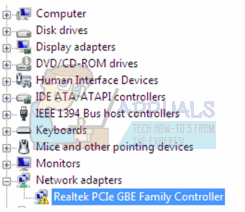How to Fix: Realtek PCIe GBE Family’s hardware-related problems
The Realtek PCIe GBE Family Controller is the driver for the LAN hardware on your motherboard. If you’re getting this error message, it is one of two options. One, there’s a conflict with the drivers, and two, you’re integrated LAN card on the motherboard is dead.
This error message might come up in situations where you don’t have any internet, and trying to do anything will result in it. It annoys a lot of users, and it appears with various versions of Windows.
There is a big chance that this is a software issue, and as such, it can be resolved in a fairly easy way. All you need to do is follow the methods described below and you will have your internet connection back in no time.

Method 1: Use a System Restore Point
Having a system restore point from a time you know everything was working great is a good thing to have, as it can save you from a lot of trouble in a situation like this. If you have one, follow the steps to return to it.
- Hold the Windows Key and Press R. Type rstrui.exe and Click OK
- Click Next, choose a restore point from a date you know everything was working, and complete the wizard. Your computer should be back as it was before the error.
Method 2: Manually install the driver
If you don’t have a System Restore Point, or would rather avoid that method, you can always try manually installing the drivers for the LAN controller. Before you start, download the drivers for your onboard network adapter from your laptop/motherboard’s manufacturer website.
- Hold the Windows Key and Press R. Type devmgmt.msc and Click OK
- Within the list of devices, expand Network Adapters and find the Realtek PCIe GBE Family Controller.
- Right-click it, and select Update Driver Software.
- Choose the Manual mode, which lets you pick your own drivers, and point it towards the correct driver you downloaded earlier.
- Let it install, reboot your device in the end, and all should be working well.
NOTE: If this doesn’t work, before updating the drivers, try to remove the battery on the motherboard for a minute, then put it back. This will reset the BIOS and help in case Windows is stuck on the old driver, and let you install the new one.
Method 3: Get a PCIe network adapter
If, by any chance, the previous methods didn’t work, that might mean that your network adapter is dead. Unfortunately, the only way to solve this is to buy a new one. Fortunately, on the other hand, PCIe network adapters are dirt cheap nowadays, all you need to do is find one that suits your needs in term of speed and compatibility with the motherboard, and you’re good to go but this will require some advanced skills to replace the adapter, so you can also get a USB Wifi Adapter and connect via Wireless if your router supports.
At the end of the day, no matter if this is a software or hardware issue, the resolution will be either free, or cost a very small amount of money if you have to buy a new network adapter. Whichever it comes out to be, the aforementioned methods will help you find the cause of your problem, and solve it as well.
